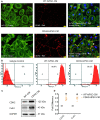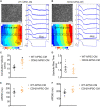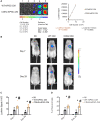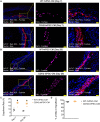N-cadherin overexpression enhances the reparative potency of human-induced pluripotent stem cell-derived cardiac myocytes in infarcted mouse hearts
- PMID: 31350544
- PMCID: PMC8204485
- DOI: 10.1093/cvr/cvz179
N-cadherin overexpression enhances the reparative potency of human-induced pluripotent stem cell-derived cardiac myocytes in infarcted mouse hearts
Abstract
Aims: In regenerative medicine, cellular cardiomyoplasty is one of the promising options for treating myocardial infarction (MI); however, the efficacy of such treatment has shown to be limited due to poor survival and/or functional integration of implanted cells. Within the heart, the adhesion between cardiac myocytes (CMs) is mediated by N-cadherin (CDH2) and is critical for the heart to function as an electromechanical syncytium. In this study, we have investigated whether the reparative potency of human-induced pluripotent stem cell-derived cardiac myocytes (hiPSC-CMs) can be enhanced through CDH2 overexpression.
Methods and results: CDH2-hiPSC-CMs and control wild-type (WT)-hiPSC-CMs were cultured in myogenic differentiation medium for 28 days. Using a mouse MI model, the cell survival/engraftment rate, infarct size, and cardiac functions were evaluated post-MI, at Day 7 or Day 28. In vitro, conduction velocities were significantly greater in CDH2-hiPSC-CMs than in WT-hiPSC-CMs. While, in vivo, measurements of cardiac functions: left ventricular (LV) ejection fraction, reduction in infarct size, and the cell engraftment rate were significantly higher in CDH2-hiPSC-CMs treated MI group than in WT-hiPSC-CMs treated MI group. Mechanistically, paracrine activation of ERK signal transduction pathway by CDH2-hiPSC-CMs, significantly induced neo-vasculogenesis, resulting in a higher survival of implanted cells.
Conclusion: Collectively, these data suggest that CDH2 overexpression enhances not only the survival/engraftment of cultured CDH2-hiPSC-CMs, but also the functional integration of these cells, consequently, the augmentation of the reparative properties of implanted CDH2-hiPSC-CMs in the failing hearts.
Keywords: Cardiac myocytes; Cardiac regeneration; Electro-mechanical syncytium; Human-induced pluripotent stem cells; Myocardial infarction; N-cadherin.
Published on behalf of the European Society of Cardiology. All rights reserved. © The Author(s) 2019. For permissions, please email: journals.permissions@oup.com.
Figures








Comment in
-
Improving the engraftment and integration of cell transplantation for cardiac regeneration.Cardiovasc Res. 2020 Mar 1;116(3):473-475. doi: 10.1093/cvr/cvz237. Cardiovasc Res. 2020. PMID: 31504255 Free PMC article. No abstract available.
References
-
- Soonpaa MH, Field LJ. Survey of studies examining mammalian cardiomyocyte DNA synthesis. Circ Res 1998;83:15–26. - PubMed
-
- Fuchs E, Segre JA. Stem cells: a new lease on life. Cell 2000;100:143–155. - PubMed
-
- Ye L, Chang YH, Xiong Q, Zhang P, Zhang L, Somasundaram P, Lepley M, Swingen C, Su L, Wendel JS, Guo J, Jang A, Rosenbush D, Greder L, Dutton JR, Zhang J, Kamp TJ, Kaufman DS, Ge Y, Zhang J. Cardiac repair in a porcine model of acute myocardial infarction with human induced pluripotent stem cell-derived cardiovascular cells. Cell Stem Cell 2014;15:750–761. - PMC - PubMed
-
- Huang P, Tian X, Li Q, Yang Y. New strategies for improving stem cell therapy in ischemic heart disease. Heart Fail Rev 2016;21:737–752. - PubMed
Publication types
MeSH terms
Substances
Grants and funding
LinkOut - more resources
Full Text Sources
Other Literature Sources
Medical
Research Materials
Miscellaneous

